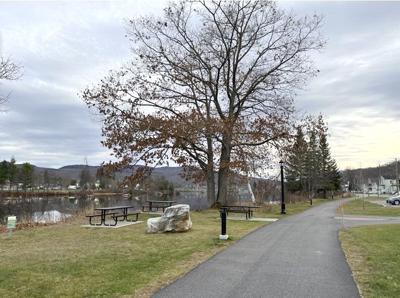
The River Walk in Berlin is one project that received funding from the Northern Border Regional Commission. President Donald Trump's budget proposal moves to eliminate the commission. (FILE PHOTO BY BARBARA TETREAULT)
BERLIN — Coos County is now officially designated as having a “distressed place-based economy” in a move designed to make the county more competitive when asking for federal funding.
The designation comes at a time when the Northern Border Regional Commission, a major source of federal funding for projects in northern New England and New York, is slated for elimination in President Donald Trump’s 2026 budget.
State Sen. David Rochefort (R-Littleton) said the designation was approved as part of the budget package Gov. Kelly Ayotte signed three weeks ago.
“We were able to get it into the state budget,” he explained. “It’s the law as of right now.”
Rochefort had sponsored Senate Bill 180, which sought the designation to help Coos County’s economy, which lags behind the rest of the state. The bill also contained a requirement that commissioners of state agencies had to consult with the Coos County Commission before making regulatory decisions that affect the county. The bill went through several amendments and ultimately died before having the designation included in the budget package.
Rochefort said the designation can help in scoring applications for federal grants, funding and investment opportunities.
“My plan is to actually use this as a stepping stone to bring other opportunities to Coos County,” said Rochefort, who cited especially going after light manufacturing and housing.
Advocating for the bill, Coos County officials said the county is characterized by high levels of poverty and unemployment, low median income, a declining population and a lack of diverse employment opportunities.
U.S. Census figures show Coos County has a per capita income of $36,850 compared to a state average of $50,867 with 12 percent of residents having incomes below the poverty line, close to double the state average of 7.2 percent. Coos County also has an older population with a median age of 49.9 compared to the state’s median age of 43.2 years old.
A March 2025 report by the Carsey School of Policy at the University of New Hampshire found that of the state’s 10 counties, only Coos County lost population between 2020 and 2024.
The report said New Hampshire had 9,000 more deaths than births between 2020 and July 2024 as the COVID pandemic hit the country. That loss in population was offset by the fact that over 40,000 people moved into the state during that time. While the state as a whole added about 30,000 residents, Coos County lost 165 residents or less than half a percent during that period.
“In northernmost Coos County, where deaths far exceeded births, migration was not sufficient to offset the natural decline leading to a modest population loss,” stated the report.
Figures released earlier this month by the N.H. Fiscal Institute show most communities in the Androscoggin Valley lost population from 2020-24.
Berlin had a decrease of 158 residents or 1.7 percent, Gorham had a decrease of 19 residents or 0.7 percent, Randolph had a decrease of two residents or 0.6 percent, and Dummer had a decrease of 8 residents or 2.6 percent. Shelburne and Milan saw small population increases with Shelburne gaining 6 residents or 1.7 percent and Milan had 2 new residents or an increase of 0.01 percent.
Over the 15 years of its existence, the Northern Border Regional Commission has provided $335 million in grants to 720 projects in the Northern Forest Region. In Coos County, funding has gone to the Berlin Riverwalk, the Coos County Family Health Services clinic expansion in Berlin, restoration of the Nansen Ski Jump, the new trail hub in Gorham, the Mount Washington Observatory and renovations to the Berlin and Coos County Historical Society's two buildings.
A commentary written by Rob Riley and Maura Adams of the Northern Forest Center describes the commission as “remarkably flexible, nimble and responsive to regional needs, whereas many other federal programs — while worthwhile — were established a generation ago and not always aligned to meet the complexity or dynamism challenging us today.”
Northern Forest Vice President Joe Short said many grants provide funding to cover only part of the cost of a project, and the applicant is expected to come up with matching funds. What makes NBRC grants especially important is they can be used as a match for other grants awarded to the recipient.
“It’s become a really important funding vehicle in the region,” he said.
Short said NBRC also recognizes that recreation is a big part of the region’s economic strategy and funds both motorized and non-motorized trail work as well as projects like the Nansen Ski Jump and the Berlin Riverwalk. He said there are not many other federal funding sources for those types of projects.
While Trump has recommended appropriating $3.4 million in his budget to wind down the commission, the final decision rests with Congress. The Senate Appropriation committee includes three members from states that are covered by the commission: Commission Chair Susan Collins (R-Maine), Jeanne Shaheen (D-N.H.), and Kirsten Gillibrand (D-N.Y.).
These articles are being shared by partners in the Granite State News Collaborative. For more information, visit collaborativenh.org.
